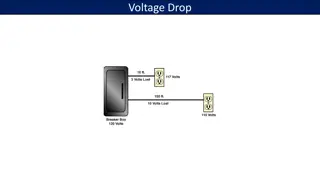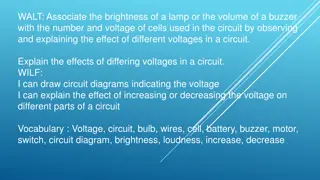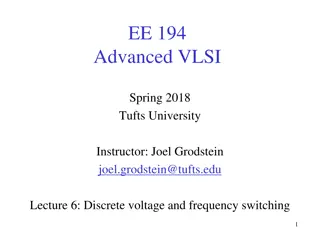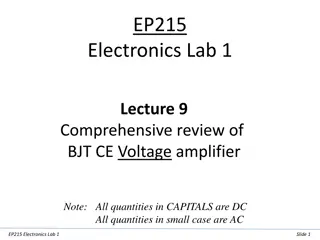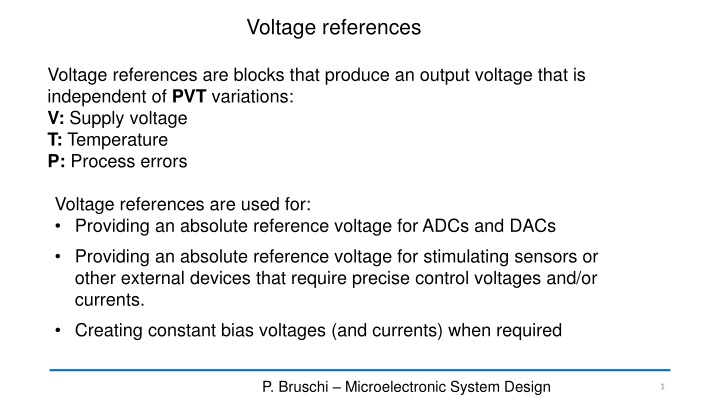
Band-Gap Voltage References and Their Importance
Explore the world of band-gap voltage references, their role in providing stable reference voltages in electronic devices, comparison with Zener diodes, and the theoretical principles behind their operation. Discover how these voltage references play a crucial role in maintaining accurate voltage levels despite varying conditions like temperature and process errors.
Download Presentation

Please find below an Image/Link to download the presentation.
The content on the website is provided AS IS for your information and personal use only. It may not be sold, licensed, or shared on other websites without obtaining consent from the author. If you encounter any issues during the download, it is possible that the publisher has removed the file from their server.
You are allowed to download the files provided on this website for personal or commercial use, subject to the condition that they are used lawfully. All files are the property of their respective owners.
The content on the website is provided AS IS for your information and personal use only. It may not be sold, licensed, or shared on other websites without obtaining consent from the author.
E N D
Presentation Transcript
Voltage references Voltage references are blocks that produce an output voltage that is independent of PVT variations: V: Supply voltage T: Temperature P: Process errors Voltage references are used for: Providing an absolute reference voltage for ADCs and DACs Providing an absolute reference voltage for stimulating sensors or other external devices that require precise control voltages and/or currents. Creating constant bias voltages (and currents) when required P. Bruschi Microelectronic System Design 1
Possible reference voltage sources Zener Diodes Problems: Require additional process steps, but only a small number of components are required for each chip (not convenient) Available voltages are > 3 V Temperature stability is poor for VZ 5-6 V The reference voltage generated by a Zener diode is noisy (very wide band noise) Band-gap circuits P. Bruschi Microelectronic System Design 2
Band-gap voltage reference: principle of operation We start with a DIODE (BJT) biased with a current IC VBG PTAT CTAT CTAT: Complementary To Absolute Temperature = + V V bV BG BE T PTAT: Proportional To Absolute Temperature dV dT @- 2 mV/K ..... - 3 mV/K BE P. Bruschi Microelectronic System Design 3
Band-gap voltage reference: determination of parameter b dV dT We have to determine the value of b, for which: = + V V bV = 0 BG BG BE T dV dT dV dT dV dT dV dT dV dT - BE = + = 0 BG b BE T = b T dV dT k q - 5 8.56 10 / V K T = @ V (290K) T V b @ 23 BE Example: dV dT @- 2 mV/K BE 0.65 0.025 23 1.225 V V @ + = BG P. Bruschi Microelectronic System Design 4
Band-Gap voltage reference: theory E kT 0 g constant 2 3 in T e I 2 i qA n D = ln V V C = F n D 2 i = E Q n I BE T I n S kT q S = D B n n V V E kT E q 0 G V V 0 0 g g = = = 0 G SI BT e T = T 4 q k T n T 1.5 constant constant IC= It is not necessary that ICis constant GT 1 B = E GT ( ) ( ) ( ) ln = + G E = ln ln V V T V V BE T GO T V V exp BT GO Gray, Hurst, Lewis, Meyer, "Analysis and design of analog integrated circuits" 4th edition, 2001 J.Wiley & Sons T P. Bruschi Microelectronic System Design 5
Band-Gap voltage reference: theory ( ) ( ) ( ) ln = + = + G E ln V V b V V V V T BG BE T BE GO T ( ) ( ) ( ) ln = + G E + ln V V V b T BG GO T VGOis numerically equivalent to Eg0 measured in eV E 0 g = V 0 G q The name "band-gap" of this reference voltage comes from VGO, which is the dominant part Let us calculate the derivative of VBGwith respect to temperature 1.2 1.2 V E eV V 0 0 g G 1 T dV dT k q ( ) ( ) ( ) ln ( ) = G E + ln BG b T V T The derivative of VBGdepends on temperature dV dT k q ( ) ( ) ( ) ( ) ln = G E + ln BG b T P. Bruschi Microelectronic System Design 6
Band-Gap voltage reference: theory We impose that the derivative of VBGis zero at a given temperature T0 k q ( ) ( ) ( ) ( ) ln G E + = ln 0 b T 0 ( ) ( + ) ( ) ln + = ln( ) G E b T 0 ( ) ( ) ( ) ln = + G E + ln V V V b T BG GO T ( ) ( + ) ( ) ( ln T ) ( ) l n = + V V V T Typically: =1 0 BG GO T kT q 1.24 V ( ) T ( ) = + 0 V V T ( ) = + + 0 0 BG G 1 ln 0 V V V 0 BG G T T 2.5 P. Bruschi Microelectronic System Design 7
Band-gap voltage reference: calculation result = + V V b V BG BE T T ( ) = + + 1 ln 0 V V V T0=323 K 0 BG G T T kT q ( ) T ( ) = + 0 V V 0 0 BG G 1 mV T0=300 K P. Bruschi Microelectronic System Design 8
Band-Gap voltage: a CMOS compatible Circuit Q2Q2 Q2 Q2 Q2 Q2 Q1 Q2 Q2 Part 1: PTAT current generator Common centroid layout For n=8 neglecting the effects of VDSon ID: = = = = 3 1 4 2 M M M M I I I 1 2 I2 I1 = V V 1 2 GS GS ( ) ( ) = = V V V V V V V V 1 1 2 2 H K G GS G GS 2 1 GS GS = V V = = + V V V V R I H K 1 2 1 H BE K BE I I I I ( ) n = R I V V = = ln 1 2 C S V ln V 1 1 2 BE BE T T area area = 1 2 S C 1 2 n 1 R q k T ( ) n = I is proportional to T (PTAT) and independent of Vdd. ln I 1 Substrate PNPs 1 P. Bruschi Microelectronic System Design 9
Band-Gap voltage: a CMOS compatible Circuit 1 R q kT = + V V IR ( ) n = ln I 3 2 BG BE 1 Biased with I =1 ( ) ln n 5 I I R kT R q I = + V V 2 3 BG BE 1 R R ( ) n = + ln V V V 2 3 BG BE T 1 = + V V b V BG BE T P. Bruschi Microelectronic System Design 10
Deriving a temperature sensor from the Band-Gap circuit 5 5 R kT R q ( ) n = ln 3 Temp V 1 P. Bruschi Microelectronic System Design 11
PTAT current generator: multiple stable states Positive feedback loop P1 fNL I2 I2=I1 P2 P1 is the correct operating point. P2 (null currents) is stable because the two mirrors have very small gains around the origin. I1 A start-up circuit is necessary to prevent the circuit from being trapped into P2 P. Bruschi Microelectronic System Design 12

